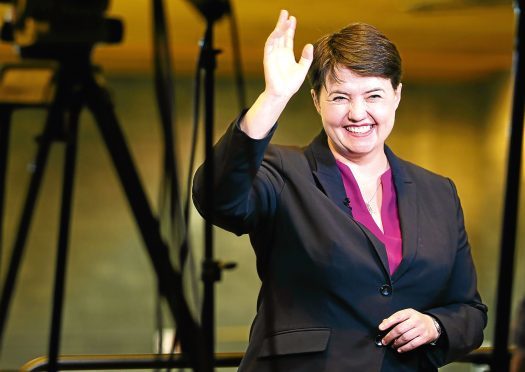The news that Ruth Davidson is thinking of leaving for Westminster confirms that Holyrood lacks the wit and humour of the Commons. She leaves for ambition, but her absence will be felt in the funereal proceedings of a dull chamber.
Ms Davidson told The Spectator magazine she would consider quitting after the 2021 Scottish elections. Previously she had declared no interest in Westminster and pledged her future to Holyrood. It appears the lure of running for leader of the UK Tory party is too great, and who can blame her.
She hints that she would still run for a Scottish seat, and so must at least dream of becoming the first Tory PM from a Scots constituency since Alec Douglas-Home, who won a by-election in Kinross and West Perthshire to assume the keys of Number 10 Downing Street in 1963.
Westminster’s gain would be Holyrood’s loss and draws into sharp focus the abysmal quality of our chamber. Ms Davidson has the merit of being funny. This is a crucial part of politics, of any role in public life. The capacity to see that some things are just daft, and that there is the thin line between serious and silly. She laughs during First Minister’s Questions, and quite often at herself.
In contrast sit po-faced government benches, with people who only cheer the most lame of loyalist slogans, and who sneer at others. Alex Salmond had a debating style that veered between him chuckling at his own humour then savaging the opposition with a mix of high pomposity and brute venom. Nicola Sturgeon learned from her master and does the same jaw-jutting aggression, the thin-eyed, sinister stare and the bully pulpit phrasing.
Thus far, neither has produced a truly great speech, and while Mr Salmond could summon drama from his words, Ms Sturgeon lacks the gift of holding the moment.
The full blame for the dreary humourlessness can’t all be put at the Nationalists’ feet. The SNP’s Duncan Hamilton – then a young MSP in the first parliament of 1999-2003 – dared to criticise the lame debating of Labour in the early days of Holyrood and came in for a barrage of abuse – he was a snob for being intolerant of different levels of education and confidence. Snob maybe, but he was right. Of Labour’s great Scottish generation, only Donald Dewar came to Holyrood and that has hampered the parliament ever since. With no standard of oratory to aim for, the parliament started middle rank and slowly sank.
It is a pity to report but there is no one in the chamber at Holyrood who excites before they get up to speak. The press rooms don’t empty, the researchers don’t flock to listen to a single speaker. Not one MSP belongs to Scotland’s great tradition of firebrand speakers, all rage and wit. While there are many fine speeches in Scottish political history, none has been made in the chamber. The only memorable one is Mr Dewar’s opening address in 1999, and that was when the parliament sat on The Mound in the Kirk General Assembly.
The public never get to see a barnstorming speech, or a funny one, as they do from Westminster. If Edinburgh politicians never match the rhetorical heights of London ones, then it suggests there is either nothing worth getting excited about or the politicians simply aren’t as good.
We once did a line in proudly independent women. The first speaker of the first parliament was Winnie Ewing. Her fans would say she was redoubtable. I always found her slightly mad. Whatever the truth, she was wonderfully herself, uninhibited by overwhelming unionist opposition or social convention. In a similar vein, Margo Macdonald was a force of nature who had to be admired, even as you ducked out of her way.
Holyrood was also home to lively characters – Tommy Sheridan, Wendy Alexander, Susan Deacon, David McLetchie, Christopher Harvie – and now there are none. It’s not that political commentators want a good joke or two for the sake of it, but that humour, passion, driving oratory are the sign of a politician who cares, who has thought through their case, who really wants things to change. Sure, sometimes its just for show, but at least there’s fun in the performance.
In planning to leave for Westminster, Ruth Davidson is acknowledging that a good politician is going to get a better reception, and meet like minds, in London and not in Edinburgh. She is not alone.
Privately, many an SNP MP will admit they wouldn’t have bothered standing for Holyrood but wanted a shot at the more demanding Westminster. Personally, I could never see Angus Robertson swapping Prime Minister’s Questions in the Commons to become a clap-hag to Nicola’s weekly performance, and Alex Salmond literally skipped with excitement when back in the Commons in 2015.
Holyrood lacks personality in part because it lacks personalities. Why are we to care for greater powers if those who hold power today seem so flaccid and humourless? What happened to caustic humour, the rapier wit, the spine-tingling oratory that used to be so common in Scotland?
